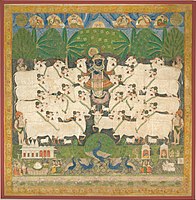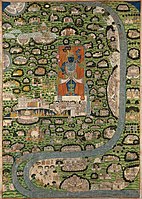Pichhwai

Pichhwai (also pichhavai, pichhvai, pechhavai etc), literally meaning 'that which hangs from the back' from the Sanskrit words "Pichh" means back and "wais" means hanging, are large devotional Hindu painted pictures, normally on cloth, which portray Krishna. They are mainly made to hang in Hindu temples of the Pushtimarg devotional tradition, especially the Shrinathji Temple in Nathdwara, Rajasthan, built around 1672. They are hung behind the idol of Shrinathji, a local form of Krishna and the centre of Pushtimarg worship, to depict his leelas. Aurangabad was another area associated with them.[2] The purpose of Pichhwais, other than artistic appeal, is to narrate tales of Krishna to the illiterate. Temples have sets with different images, which are changed according to the calendar of festivals celebrating the deity.[3]
Nathdwara painting covers these and similar works in other genres, especially Indian miniature paintings. Like the Pushtimarg tradition, they originated in the Deccan, but are now mainly associated with Western India.
Modern production[]
Pichhwai have become the main export of Nathdwara and are in much demand among foreign visitors. The artists live mostly in Chitron ki gali (Street of paintings) and Chitrakaron ka mohallah (colony of painters) and make a close community with constant interaction. Often a Pichhwai painting is a group effort, where several skilful painters work together under the supervision of a master artist.
There has also been a push by other artists and designers to preserve and showcase this art form to a wider, international audience. Designers have utilised the traditional colours, printing techniques and pattern styles associated Pichhwai, in clothing attires and showcase them on international platforms such as Lakmé Fashion Week [4].

Festival of the Cattle (Gopashtami); shrine hanging, 19th century, 223 cm (87.79″) x 220 cm (86.61″)

Gopis and cows, late 18th century, cotton plain-weave, dyed and painted with opaque watercolors, gold and silver, 244 cm (96.06″) x 254 cm (100″)

Kota school, Rajasthan, "Priests worshipping Krishna as Shrinathji for Mountain of Food festival (Annakuta utsava), c. 1840, 188.5 cm (74.21″) x 144.5 cm (56.88″)

Krishna as Shrinathji and the Dancing Gopis, from the temple of Nathdvara, 19th century

Unusual pichhwai showing the Vraj Parikrama, a circular pilgrimage route around the locations of Krishna's life, 65¾ x 47 in. (168 x 120 cm.), 19th century.
Notes[]
| Wikimedia Commons has media related to Pichhwai. |
- ^ This pichhwai is in the collection of the Metropolitan Museum of Art, a gift of The Friends of Asian Art in 2003 and may be seen in Gallery 243. (Accession #2003.177)
- ^ Blurton, 142-143; Harle, 393
- ^ Blurton, 142-143
- ^ Sachwani, Nikita (May 2021). "REJUVENATING FOLK PAINTINGS ON TEXTILE PRODUCTS: A REVIEW" (PDF). Textile Value Chain.
References[]
- Blurton, T. Richard, Hindu Art, 1994, British Museum Press, ISBN 0 7141 1442 1
- Harle, J.C., The Art and Architecture of the Indian Subcontinent, 2nd edn. 1994, Yale University Press Pelican History of Art, ISBN 0300062176
- Vaishnavism
- Rajasthani arts
- Genres of Indian art
- Rajsamand district
- Indian painting




